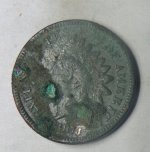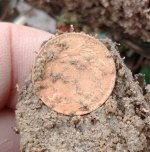OwenT
Hero Member
I've not had much to do while on Christmas break so I've been doing lots of armchair prospecting and general research. I came across this report: The Effects of Sediment and Mercury Mobilization in the South Yuba River and Humbug Creek Confluence Area, Nevada County, California: Concentrations, Speciation, and Environmental Fate—Part 1: Field Characterization
(If yo don't want to read just skip to the bottom to my qestions)
I read the abstract and I thought it was interesting. Being from Washington and not being a dredger, I'm not all that in the know with the finer points of all that's happened in California over the last several years although I do try to keep informed because I like dredging and I hope I get to do it sometime. Maybe this is a report that many of you are already familiar with.
What I took from just the abstract was that the BLM participated in a study to determine what effect dredging has on the mobilization of mercury as to evaluate the possibility of suction dredging to systematically remove mercury from the river. One thing that caught my interest was the 5th objective being : "5) a comparison of potential Hg transport caused by natural storm disturbances with potential Hg mobilization caused by suction dredging as a method of Hg removal at the study site."
Up to this point I had know that dredging captures and removes mercury from the waterway which is obviously good, that some is also mobilized into the water which is bad, and that high runoff stirs up to whole river and mobilizes mercury. I assume that high water mobilizes so much mercury as to make any effect of dredging completely insignificant. I also know that anti-dredgers directly oppose that thought so I'd like to know if there's anything behind that.
Towards the end of the abstract is it suggested that mercury levels were lower in 2008 than 2007 once suction dredging was banned then this conclusion follows:
"Results from the field studies indicate that disturbance of the finegrained Hg-contaminated sediment would likely lead to enhanced mobilization of Hg to downstream environments; therefore, the use of suction dredging to remove Hg at the South Yuba River and Humbug Creek confluence area would likely result in enhanced Hg transport downstream relative to natural conditions."
When I read that I thought, "well obviously if you dredge, more Hg is going to be mobilized than if you weren't dredging. Anyone could figure that out." The question is then, how much?
In the report it is concluded that " if material similar to the compact sediment and bedrock contact materials are dredged, sediment with much higher THg content would be mobilized, and only approximately 100 to 1,000 hours of dredging would be required to exceed an average dry year’s natural watershed THg load "
but,
"implying only about 270 hours of dredging per permit per year are required to reach the 1,000,000 hour mark. This estimate of dredge time is reasonable for a statewide assessment but would be unlikely for only the South Yuba River. Furthermore, this estimate accounts for the dredging of the Hg-rich layers exclusively, a situation that is unlikely given the variable spatial distribution of these Hg-rich layers"
Later it is stated that effects of dredging account for maybe 35% of suspended Hg load in relic high mercury density sediments.
By the end of the report I am made to believe that if dredgers distrub the so called relic HMD they are mobilizing significant amounts of Hg more than the river doesn on it's own. I'm not sure if they were taking into account periods of high flow or only the suspended load at a given time during normal water. Apparently to the BLM, leaving it undisturbed is preferable to removing it and potential moblilizing more. Is this same HDM material not mixed up with all the rest of the river during floods or is it only usually disturbed by dredgers?
I just want to get a little more understanding here. While reading I'm thinking of ways that the study could be invalid or the data skewed or manipulated to make it look worse than it is or that these people are just plain crooked but I'm not seeing it haha.
So, I don't want this to be a debate between anyone on here but I want to hear from some of you especially dredgers from CA. In general, are dredgers mobilizing harmful amounts of mercury that otherwise would be safely tucked away in the riverbed? Is there any REAL case against dredging? What is the opposition at this point? What about dredging where there isn't as much Hg? How will Hg be dealt with in the future? What is the solution to all this?
(If yo don't want to read just skip to the bottom to my qestions)
I read the abstract and I thought it was interesting. Being from Washington and not being a dredger, I'm not all that in the know with the finer points of all that's happened in California over the last several years although I do try to keep informed because I like dredging and I hope I get to do it sometime. Maybe this is a report that many of you are already familiar with.
What I took from just the abstract was that the BLM participated in a study to determine what effect dredging has on the mobilization of mercury as to evaluate the possibility of suction dredging to systematically remove mercury from the river. One thing that caught my interest was the 5th objective being : "5) a comparison of potential Hg transport caused by natural storm disturbances with potential Hg mobilization caused by suction dredging as a method of Hg removal at the study site."
Up to this point I had know that dredging captures and removes mercury from the waterway which is obviously good, that some is also mobilized into the water which is bad, and that high runoff stirs up to whole river and mobilizes mercury. I assume that high water mobilizes so much mercury as to make any effect of dredging completely insignificant. I also know that anti-dredgers directly oppose that thought so I'd like to know if there's anything behind that.
Towards the end of the abstract is it suggested that mercury levels were lower in 2008 than 2007 once suction dredging was banned then this conclusion follows:
"Results from the field studies indicate that disturbance of the finegrained Hg-contaminated sediment would likely lead to enhanced mobilization of Hg to downstream environments; therefore, the use of suction dredging to remove Hg at the South Yuba River and Humbug Creek confluence area would likely result in enhanced Hg transport downstream relative to natural conditions."
When I read that I thought, "well obviously if you dredge, more Hg is going to be mobilized than if you weren't dredging. Anyone could figure that out." The question is then, how much?
In the report it is concluded that " if material similar to the compact sediment and bedrock contact materials are dredged, sediment with much higher THg content would be mobilized, and only approximately 100 to 1,000 hours of dredging would be required to exceed an average dry year’s natural watershed THg load "
but,
"implying only about 270 hours of dredging per permit per year are required to reach the 1,000,000 hour mark. This estimate of dredge time is reasonable for a statewide assessment but would be unlikely for only the South Yuba River. Furthermore, this estimate accounts for the dredging of the Hg-rich layers exclusively, a situation that is unlikely given the variable spatial distribution of these Hg-rich layers"
Later it is stated that effects of dredging account for maybe 35% of suspended Hg load in relic high mercury density sediments.
By the end of the report I am made to believe that if dredgers distrub the so called relic HMD they are mobilizing significant amounts of Hg more than the river doesn on it's own. I'm not sure if they were taking into account periods of high flow or only the suspended load at a given time during normal water. Apparently to the BLM, leaving it undisturbed is preferable to removing it and potential moblilizing more. Is this same HDM material not mixed up with all the rest of the river during floods or is it only usually disturbed by dredgers?
I just want to get a little more understanding here. While reading I'm thinking of ways that the study could be invalid or the data skewed or manipulated to make it look worse than it is or that these people are just plain crooked but I'm not seeing it haha.
So, I don't want this to be a debate between anyone on here but I want to hear from some of you especially dredgers from CA. In general, are dredgers mobilizing harmful amounts of mercury that otherwise would be safely tucked away in the riverbed? Is there any REAL case against dredging? What is the opposition at this point? What about dredging where there isn't as much Hg? How will Hg be dealt with in the future? What is the solution to all this?





